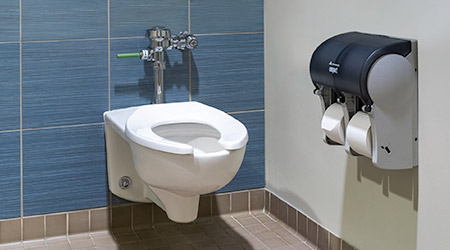The average life expectancy in the United States is just under 79 and that number is expected to rise in the future. With these advances, people are living more of their years with disabilities and illnesses that come with the increased ages. Healthcare facilities need to cater to this changing demographic in all areas of their operations, including restroom design and construction.
Trends are emerging in healthcare facility bathrooms. Ruben Cantu is the plumbing manager at Rush University Medical Center in Chicago. Cantu points to two trends in restroom design and construction: becoming eco-friendly along with infection control awareness. "The goals of these current trends are to have greener buildings, create utility conservation/savings, and increase patient safety," said Cantu.
Water conservation
Mark Lawinger is the product line manager for fixtures and healthcare for the Sloan Valve Co. Sloan has been around since 1906 and is a manufacturer of commercial plumbing systems with an emphasis on developing products conducive to healthcare environments. Lawinger pointed to a few products — sensor activated faucets, soap dispensers, hand dryers and flushometers — which enable healthcare facilities to conserve water and reduce costs.
According to Lawinger, the Sloan ECOS flushometer reduces water volume by up to 30 percent, while Sloan waterless urinals eliminate water consumption completely.
Reducing water has safety benefits as well. When water gets on the floor, it is slippery and causes a safety hazard. Sloan’s AER-DEC Integrated Sink System features a soap dispenser, faucet, hand dryer and sink basin with all four elements working together to create a highly efficient system, eliminating the need to hold wet hands over the floor to reach for soap or paper towels.
"Other ways medical facilities can help prevent falls is to install grab bars and have ADA compliant products and fixtures," said Lawinger.
Minimizing infection possibilities
Keeping medical facilities clean and free of infections is a tall task. This is particularly true in restroom facilities, but fixtures have evolved to take infection control concerns into consideration. Sensory activated faucets, soap dispensers, hand dryers and flushometers reduce touch. Faucets with LCD screens that feature countdown timers ensure users put in the proper time while rinsing and soaping during hand-washing. Solid surface materials (non-porous) prevents bacteria and germs from harboring and makes it easier to clean. Faucets with line purges reduce legionella.
Lawinger noted that Sloan carries products for each of these services and said they are, "committed to providing healthcare facilities with hands-free and hygienic products to enhance user safety and comfort, while cutting down on healthcare acquired illnesses (HAIs)."
The restrooms at Rush University Medical Center include faucets with laminar flow aerators, new toilets with EverClean coating, hands-free flush valves on toilets/urinals and uppercut dual flush handles. "We periodically review and up-date project requirements to meet current codes and standards and reduce the potential for the spread of infections," said Cantu.
Avoiding the institutional feel
For both patients and visitors, being in a medical facility can be stressful. One way for medical facilities to ease the stress is to create a pleasant and comfortable atmosphere. Restroom designs can be part of that atmosphere despite the focus on practicality. With the wide range of offerings, styles and special finishes, restroom accessories can contribute to an attractive space.
"Attention to style and aesthetics is easier than ever with today’s modern looking, stylish sensor faucets, soap dispensers, hand dryers, and flushometers," said Lawinger.
Rush University Medical Center is very aware of style and aesthetics and deliberately avoids an institutional feel. According to Cantu, they do this by using warm colors in bathroom walls, floors, and wall tile.
Age/size considerations
At whatever stage they have been, baby boomers have constituted a large percentage of the American population. As they age, their influence is being felt in the geriatric fields. In addition to aging, the American population is growing rounder. The percentage of people who are considered overweight or obese is nearly two thirds.1 Restrooms in medical facilities need to be constructed and maintained with both of these facts in mind.
ADA Guidelines and current codes have been established in accordance with the aging and rounding of America. Lawinger said, "Toilets with ADA-compliant heights are not just for wheelchair patients, they’re also easier for the elderly to use. Use of floor-mounted closets are preferable to hung closets in areas for larger bariatric patients."
The trends in medical facilities restroom design and construction satisfy a range of goals. Restrooms have become safer, healthier, more attractive, and greener. That counts as win for all those who use, maintain, and manage the facilities.
1 https://www.niddk.nih.gov/health-information/health-statistics/overweight-obesity

 UF Health Hospitals Rely on Green Globes to Realize Their Full Potential
UF Health Hospitals Rely on Green Globes to Realize Their Full Potential How Healthcare Facilities Can Be Truly Disaster-Resilient
How Healthcare Facilities Can Be Truly Disaster-Resilient TriasMD Breaks Ground on DISC Surgery Center for San Fernando Valley
TriasMD Breaks Ground on DISC Surgery Center for San Fernando Valley Bigfork Valley Hospital Falls Victim to Data Breach
Bigfork Valley Hospital Falls Victim to Data Breach AI-Driven Facilities: Strategic Planning and Cost Management
AI-Driven Facilities: Strategic Planning and Cost Management